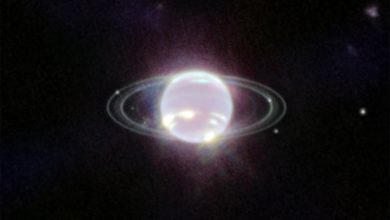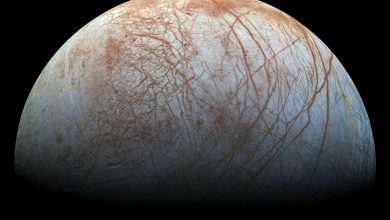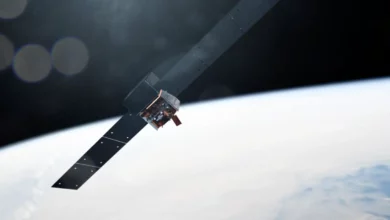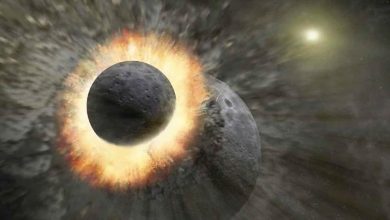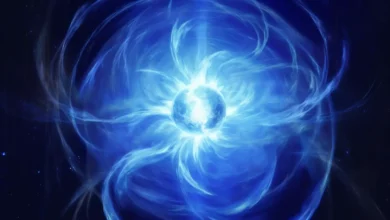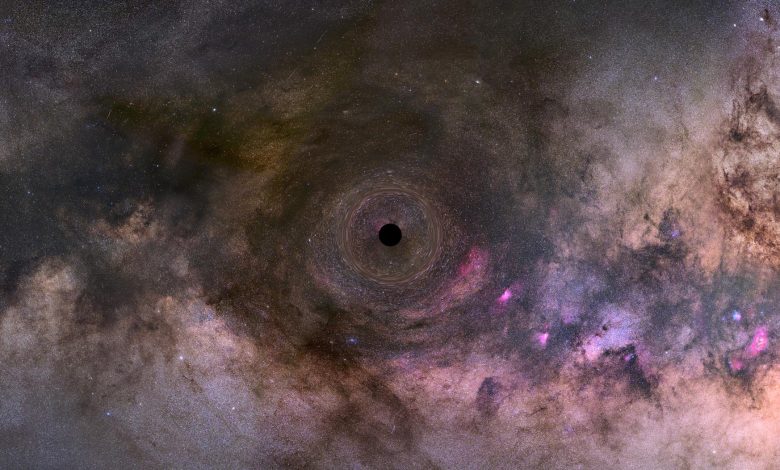
Lead Image: This is an illustration of a close-up look at a black hole drifting through our Milky Way galaxy. The black hole is the crushed remnant of a massive star that exploded as a supernova. The surviving core is several times the mass of our Sun. The black hole traps light due to its intense gravitational field. The black hole distorts the space around it, which warps images of background stars lined up almost directly behind it. This gravitational “lensing” effect offers the only telltale evidence for the existence of lone black holes wandering our galaxy, which may be a population of 100 million. The Hubble Space Telescope goes hunting for these black holes by looking for distortion in starlight as the black holes drift in front of background stars. Credit: FECYT, IAC
Hubble Determines Mass of Black Hole Isolated Black Hole
Supermassive black holes, such as Sagittarius A* — the black hole at the center of the Milky Way galaxy — lie at the center of virtually all galaxies. However, a small stellar mass black hole, which is sometimes left behind when massive stars explode in a supernova, can be on their own, isolated in space.
It is estimated that approximately one in a thousand stars is massive enough to give birth to a black hole. Since the galaxy.
By their very nature, black holes can be very hard to detect, especially if they are isolated. A key feature of black holes is that their gravitational pull is so powerful that even light can’t escape. This means we generally detect them by their gravitational influence on other objects or by radiation created by the surrounding matter they are feeding on. Without any nearby objects or accreting matter, there could be hundreds of millions of black holes throughout our galaxy that are essentially invisible to astronomers on Earth.
Our Milky Way galaxy is haunted. The vast gulf of space between the stars is plied by the dead, burned-out, and crushed remnants of once glorious stars. These black holes cannot be directly seen because their intense gravity swallows light. Like legendary wandering ghosts, their presence can only be deduced by seeing how they affect the environment around them.
Imagine crushing the mass of a fleet of battleships into something no bigger than a baseball. That only begins to describe the infinite density locked away into a black hole left over from a stellar explosion. The black hole is typically several times the mass of our Sun. The intense gravity from something so dense warps the fabric of space around it, like a bowling ball rolling across the skin of a trampoline. Starlight passing near this gravitational pothole in space is deflected. And this is how the phantom black holes are found.
Astronomers estimate that there should be 100 million black holes roaming among the 100 billion stars in our galaxy. But since black holes emit no light of their own, they are extremely difficult to detect. Now, astronomers have at last come up with clear evidence for finding one in a needle-in-a-haystack search among a blizzard of stars seen toward the galactic center. The light from a star far behind the black hole was momentarily brightened and deflected by the black hole passing in front of it. This was a long and painstaking measurement that the Hubble Space Telescope’s exquisite resolution is well-suited for. The black hole’s powerful gravitation left a unique fingerprint on the deflection of starlight, eliminating other potential gravitational lensing candidates.
No need for us to worry because the black hole is 5,000 light-years away. But, statistically, this detection means that the nearest wandering black hole to Earth could be no more than 80 light-years away.
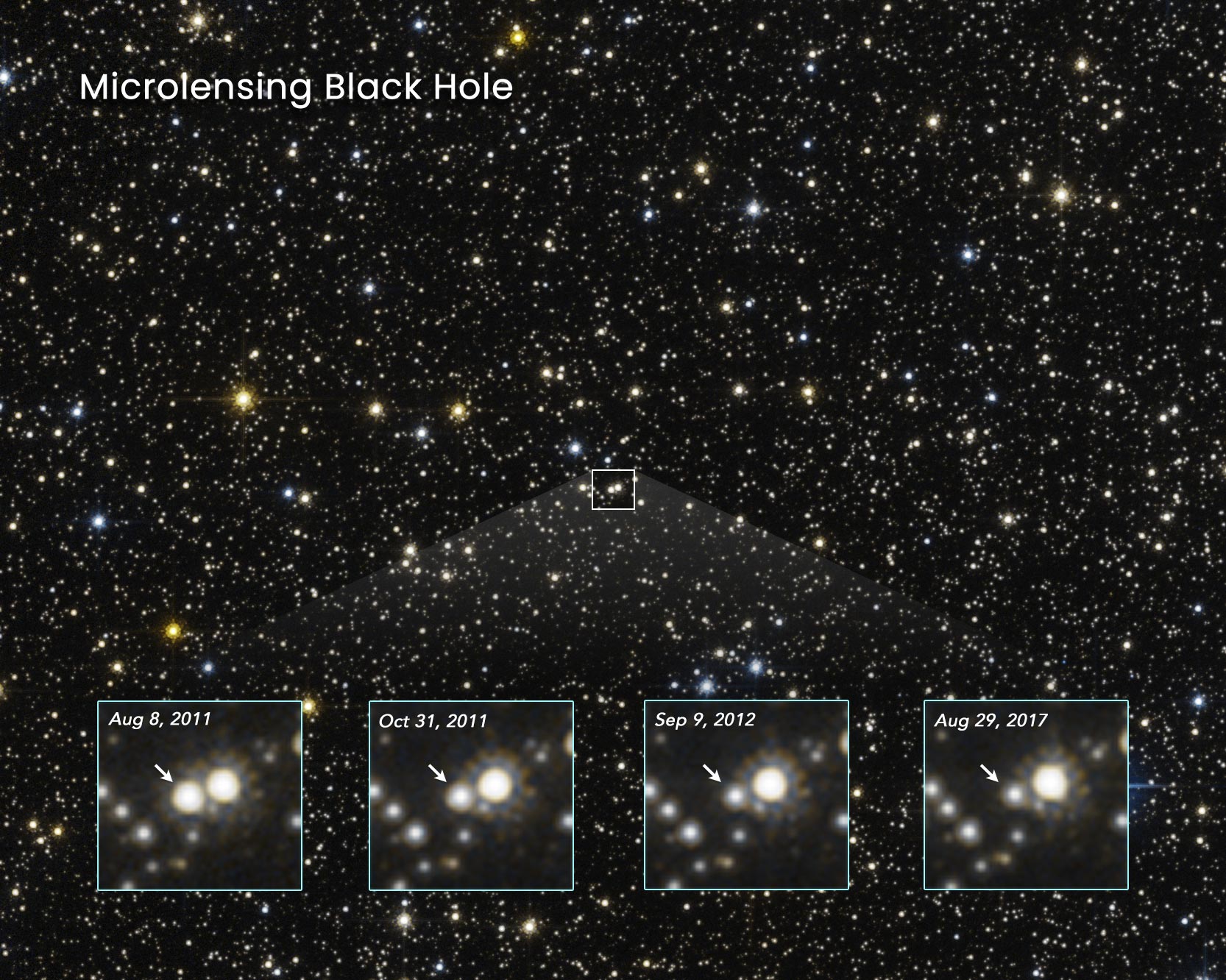
Hubble Space Telescope Determines Mass of Isolated Black Hole Roaming Our Milky Way Galaxy
Astronomers estimate that 100 million black holes roam among the stars in our Milky Way galaxy, but they have never conclusively identified an isolated black hole. Following six years of meticulous observations, NASA’s Hubble Space Telescope has, for the first time ever, provided direct evidence for a lone black hole drifting through interstellar space by a precise mass measurement of the phantom object. Until now, all black hole masses have been inferred statistically, or through interactions in binary systems or in the cores of galaxies. Stellar-mass black holes are usually found with companion stars, making this one unusual.
The newly detected wandering black hole lies about 5,000 light-years away, in the Carina-Sagittarius spiral arm of our galaxy. However, its discovery allows astronomers to estimate that the nearest isolated stellar-mass black hole to Earth might be as close as 80 light-years away. The nearest star to our solar system, Proxima Centauri, is a little over 4 light-years away.
Black holes roaming our galaxy are born from rare, monstrous stars (less than one-thousandth of the galaxy’s stellar population) that are at least 20 times more massive than our Sun. These stars explode as supernovae, and the remnant core is crushed by gravity into a black hole. Because the self-detonation is not perfectly symmetrical, the black hole may get a kick, and go careening through our galaxy like a blasted cannonball.
Telescopes can’t photograph a wayward black hole because it doesn’t emit any light. However, a black hole warps space, which then deflects and amplifies starlight from anything that momentarily lines up exactly behind it.
Ground-based telescopes, which monitor the brightness of millions of stars in the rich star fields toward the central bulge of our Milky Way, look for a tell-tale sudden brightening of one of them when a massive object passes between us and the star. Then Hubble follows up on the most interesting such events.
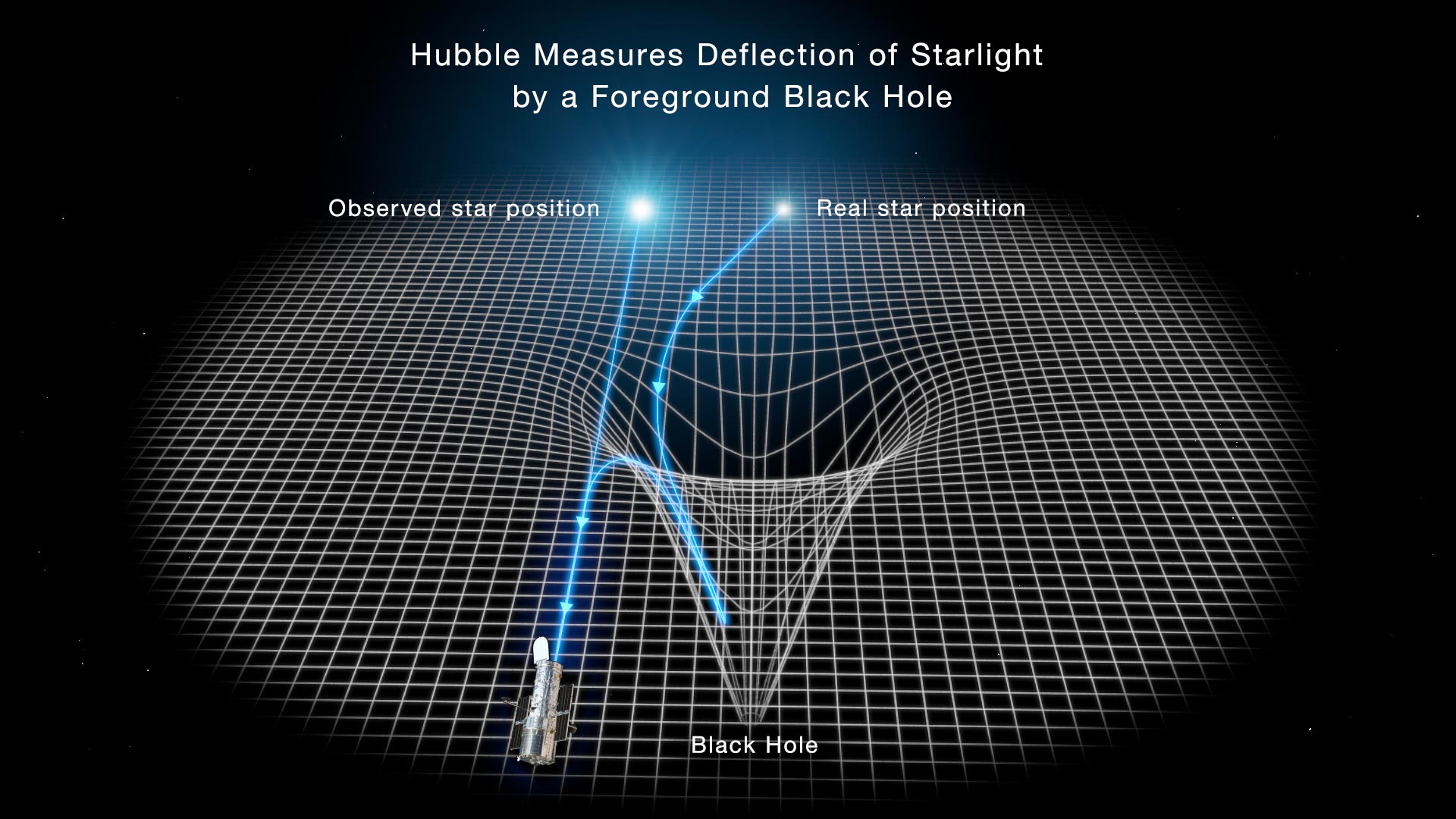
Two teams used Hubble data in their investigations — one[1] led by Kailash Sahu of the Space Telescope Science Institute in Baltimore, Maryland; and the other[2] by Casey Lam of the University of California, Berkeley. The teams’ results differ slightly, but both suggest the presence of a compact object.
The warping of space due to the gravity of a foreground object passing in front of a star located far behind it will momentarily bend and amplify the light of the background star as it passes in front of it. Astronomers use the phenomenon, called gravitational microlensing, to study stars and exoplanets in the approximately 30,000 events seen so far inside our galaxy.
The signature of a foreground black hole stands out as unique among other microlensing events. The very intense gravity of the black hole will stretch out the duration of the lensing event for over 200 days. Also, if the intervening object was instead a foreground star, it would cause a transient color change in the starlight as measured because the light from the foreground and background stars would momentarily be blended together. But no color change was seen in the black hole event.
Next, Hubble was used to measure the amount of deflection of the background star’s image by the black hole. Hubble is capable of the extraordinary precision needed for such measurements. The star’s image was offset from where it normally would be by about a milliarcsecond. That’s equivalent to measuring the diameter of a 25-cent coin in Los Angeles as seen from New York City.
This astrometric microlensing technique provided information on the mass, distance, and velocity of the black hole. The amount of deflection by the black hole’s intense warping of space allowed Sahu’s team to estimate that it weighs seven solar masses.
Lam’s team reports a slightly lower mass range, meaning that the object may be either a neutron star or a black hole. They estimate that the mass of the invisible compact object is between 1.6 and 4.4 times that of the Sun. At the high end of this range the object would be a black hole; at the low end, it would be a neutron star.
“As much as we would like to say it is definitely a black hole, we must report all allowed solutions. This includes both lower-mass black holes and possibly even a neutron star,” said Jessica Lu of the Berkeley team.
“Whatever it is, the object is the first dark stellar remnant discovered wandering through the galaxy unaccompanied by another star,” Lam added.
This was a particularly difficult measurement because there is a bright, unrelated star that is extremely close in angular separation to the source star. “So it’s like trying to measure the tiny motion of a firefly next to a bright light bulb,” said Sahu. “We had to meticulously subtract the light from the nearby bright star to precisely measure the deflection of the faint source.”
Sahu’s team estimates the isolated black hole is traveling across the galaxy at 100,000 miles per hour, or 160,000 kilometers (fast enough to travel from Earth to the Moon in less than three hours). That’s faster than most of the other neighboring stars in that region of our galaxy.
“Astrometric microlensing is conceptually simple but observationally very tough,” said Sahu. “Microlensing is the only technique available for identifying isolated black holes.” When the black hole passed in front of a background star located 19,000 light-years away in the galactic bulge, the starlight coming toward Earth was amplified for a duration of 270 days as the black hole passed by. However, it took several years of Hubble observations to follow how the background star’s position appeared to be deflected by the bending of light by the foreground black hole.
The existence of stellar-mass black holes has been known since the early 1970s, but all of their mass measurements—until now—have been in binary star systems. Gas from the companion star falls into the black hole and is heated to such high temperatures that it emits X-rays. About two dozen black holes have had their masses measured in X-ray binaries through their gravitational effect on their companions. Mass estimates range from 5 to 20 solar masses. Black holes detected in other galaxies by gravitational waves from mergers between black holes and companion objects have been as high as 90 solar masses.
“Detections of isolated black holes will provide new insights into the population of these objects in our Milky Way,” said Sahu. But it is a needle-in-a-haystack search. The prediction is that only one in a few hundred microlensing events are caused by isolated black holes.
NASA’s upcoming Nancy Grace Roman Space Telescope will discover several thousand microlensing events out of which many are expected to be black holes, and the deflections will be measured with very high accuracy.
In a 1916 paper on general relativity, Albert Einstein predicted that his theory could be tested by observing the Sun’s gravity offsetting the apparent position of a background star. This was tested by a collaboration led by astronomers Arthur Eddington and Frank Dyson during a solar eclipse on May 29, 1919. Eddington and his colleagues measured a background star being offset by 2 arcseconds, validating Einstein’s theories. These scientists could hardly have imagined that over a century later this same technique would be used – with unimaginable precision of a thousandfold better — to look for black holes across the galaxy.
References:
“An Isolated Stellar-Mass Black Hole Detected Through Astrometric Microlensing” by Kailash C. Sahu, Jay Anderson, Stefano Casertano, Howard E. Bond, Andrzej Udalski, Martin Dominik, Annalisa Calamida, Andrea Bellini, Thomas M. Brown, Marina Rejkuba, Varun Bajaj, Noe Kains, Henry C. Ferguson, Chris L. Fryer, Philip Yock, Przemek Mroz, Szymon Kozlowski, Pawel Pietrukowicz, Radek Poleski, Jan Skowron, Igor Soszynski, Michael K. Szymanski, Krzysztof Ulaczyk, Lukasz Wyrzykowski, Richard Barry, David P. Bennett, Ian A. Bond, Yuki Hirao, Stela Ishitani Silva, Iona Kondo, Naoki Koshimoto, Clement Ranc, Nicholas J. Rattenbury, Takahiro Sumi, Daisuke Suzuki, Paul J. Tristram, Aikaterini Vandorou, Jean-Philippe Beaulieu, Jean-Baptiste Marquette, Andrew Cole, Pascal Fouque, Kym Hill, Stefan Dieters, Christian Coutures, Dijana Dominis-Prester, Clara Bennett, Etienne Bachelet, John Menzies, Michael Alb-row, Karen Pollard, Andrew Gould, Jennifer Yee, William Allen, Leonardo Andrade de Almeida, Grant Christie, John Drummond, Avishay Gal-Yam, Evgeny Gorbikov, Francisco Jablonski, Chung-Uk Lee, Dan Maoz, Ilan Manulis, Jennie McCormick, Tim Natusch, Richard W. Pogge, Yossi Shvartzvald, Uffe G. Jorgensen, Khalid A. Alsubai, Michael I. Andersen, Valerio Bozza, Sebastiano Calchi Novati, Martin Burgdorf, Tobias C. Hinse, Markus Hundertmark, Tim-Oliver Husser, Eamonn Kerins, Penelope Longa-Pena, Luigi Mancini, Matthew Penny, Sohrab Rahvar, Davide Ricci, Sedighe Sajadian, Jesper Skottfelt, Colin Snodgrass, John Southworth, Jeremy Tregloan-Reed, Joachim Wambsganss, Olivier Wertz, Yiannis Tsapras, Rachel A. Street, Daniel M. Bramich, Keith Horne and Iain A. Steele, 25 May 2022, Astrophysics > Solar and Stellar Astrophysics.
arXiv:2201.13296
“An isolated mass gap black hole or neutron star detected with astrometric microlensing” by Casey Y. Lam, Jessica R. Lu, Andrzej Udalski, Ian Bond, David P. Bennett, Jan Skowron, Przemek Mroz, Radek Poleski, Takahiro Sumi, Michal K. Szymanski, Szymon Kozlowski, Pawel Pietrukowicz, Igor Soszynski, Krzysztof Ulaczyk, Lukasz Wyrzykowski, Shota Miyazaki, Daisuke Suzuki, Naoki Koshimoto, Nicholas J. Rattenbury, Matthew W. Hosek Jr., Fumio Abe, Richard Barry, Aparna Bhattacharya, Akihiko Fukui, Hirosane Fujii, Yuki Hirao, Yoshitaka Itow, Rintaro Kirikawa, Iona Kondo, Yutaka Matsubara, Sho Matsumoto, Yasushi Muraki, Greg Olmschenk, Clement Ranc, Arisa Okamura, Yuki Satoh, Stela Ishitani Silva, Taiga Toda, Paul J. Tristram, Aikaterini Vandorou, Hibiki Yama, Natasha S. Abrams, Shrihan Agarwal, Sam Rose and Sean K. Terry, Accepted, The Astrophysical Journal Letters.
arXiv:2202.01903
The Hubble Space Telescope is a project of international cooperation between NASA and ESA (European Space Agency). NASA’s Goddard Space Flight Center in Greenbelt, Maryland, manages the telescope. The Space Telescope Science Institute (STScI) in Baltimore, Maryland, conducts Hubble science operations. STScI is operated for NASA by the Association of Universities for Research in Astronomy in Washington, D.C.

